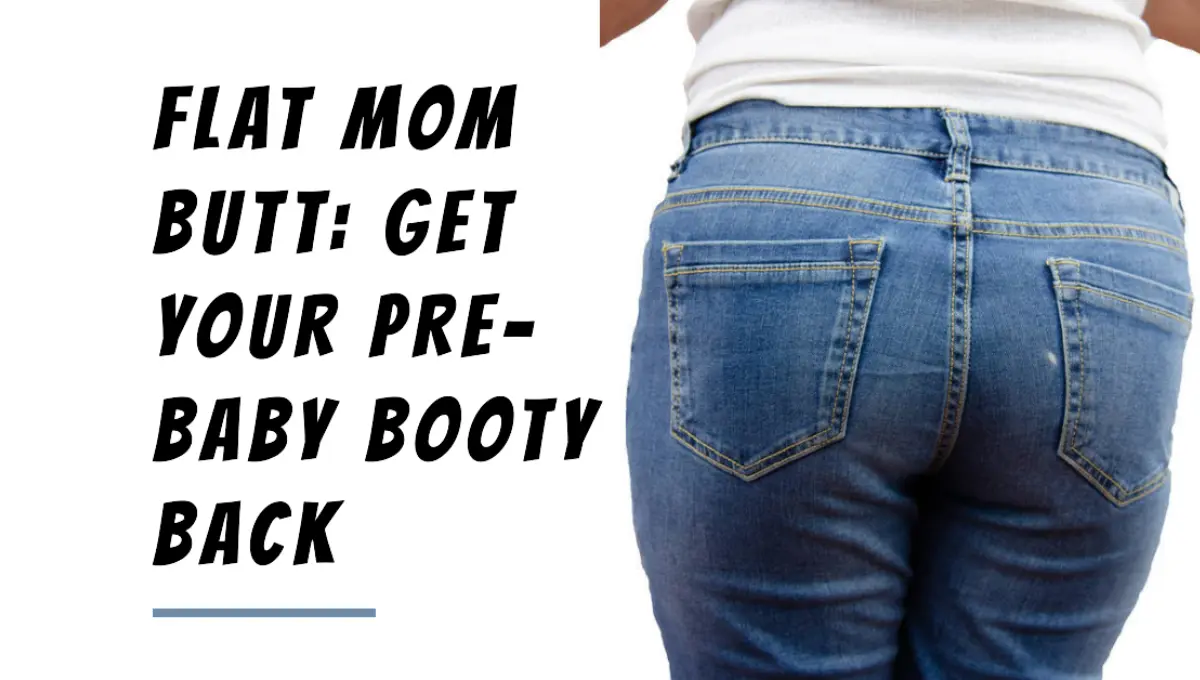
In this article on PregnancyBoss, we will delve into the common issue known as “flat mom butt” and provide you with valuable insights on why it happens and how to effectively address it. “Flat mom butt” is a term often used to describe the loss of tone and shape in the gluteal muscles that can occur after pregnancy. Fortunately, there are ways to combat this and regain confidence in your body. Let’s explore the factors contributing to “flat mom butt” and discover the exercises and tips to get rid of it.
Related: Diastasis Recti During Pregnancy: Prevention, Treatment, and Exercises
What is Flat Mom Butt?
A “flat mom butt” is a term used to describe the flattening or sagging of the buttocks that can occur during or after pregnancy. This can be caused by changes in the body during pregnancy, such as weight gain, hormonal changes, and postural adaptations. It can also be caused by a lack of exercise or physical activity. However, the good news is that it is possible to rebuild and strengthen the glutes through exercise and healthy eating habits.
Related: Aches and Pains of Pregnancy: Understanding and Coping
What Causes a Flat Mom Butt?
After giving birth, many new moms report having a flat mom butt, also known as “flat mom butt” or “dormant butt syndrome” or “pancake butt.” The following factors contribute to a flattening butt in new moms:
- Muscular imbalances: During pregnancy, the body undergoes many changes, including weight gain and hormonal fluctuations. These changes can lead to muscular imbalances, particularly in the glutes, which can cause the butt to appear flatter.
- Postural changes: Postural adaptations to a growing belly and shifting center of gravity during pregnancy can lead to postural changes, such as tucking the butt under and/or shifting the hips forward (sway posture). Similarly, many people thrust their hips forward as they carry around their baby, which can change the appearance of the butt.
- Dead butt syndrome: Dead butt syndrome is common after pregnancy because of the dramatic alignment shifts both during and after pregnancy. These shifts are caused by weakened gluteal muscles, which can lead to a flat mom butt.
Related: How to Deal with Pregnancy Insomnia?
Why Is It Important to Fix a Flat Mom Butt?
It is important to fix a flat mom butt for several reasons, including:
- Improved posture: A flat mom butt can contribute to poor posture, which can lead to back pain and other discomforts. By strengthening the glutes, new moms can improve their posture and reduce the risk of pain and injury.
- Increased confidence: Many new moms report feeling self-conscious about their post-baby bodies, including their flat mom butts. By working to rebuild their glutes, they can feel more confident and comfortable in their own skin.
- Better overall health: Strengthening the glutes can improve overall health and fitness levels. Strong glutes can help with everyday movements like walking, lifting, and carrying, as well as more intense workouts.
- Reduced risk of injury: Weak glutes can contribute to a variety of injuries, including knee pain and lower back pain. By strengthening the glutes, new moms can reduce their risk of injury and improve their overall health and well-being.
Related: How to Deal with Pregnancy Constipation?
What are the Tips to Transform Your Flat Mom Butt?
Enhancing the strength and enhancing the size and shape of your buttocks can be achieved by incorporating glute-focused exercises, strength training routines, and implementing straightforward strategies into your daily life.
Self-Reflection
Before delving into the exercises, it’s essential to address your posture, specifically focusing on the tendency to clench your buttocks.
During pregnancy, individuals often become accustomed to tensing their glutes, and this habit may persist long after childbirth without them realizing it. Take a moment to self-reflect.
- Consciously contract your glute muscles tightly and then release them. Notice the contrast?
- Throughout the day, remind yourself by asking, “Are my buttocks tensed?” Experiment with this in front of a mirror, while completing household chores, or even while holding a baby.
- The objective is to find a neutral posture. With practice, you will gradually break free from the habit of excessive clenching. However, avoid overcompensating by arching your lower back and pushing out your chest, as this can lead to an anterior pelvic tilt and tightened hip flexors.
Optimal Posture vs. Poor Posture
Adjust Your Stance Arguably the most crucial tip I can offer—one that yields immediate benefits—is to adjust your stance.
Employing a staggered stance is particularly vital when carrying your children.
Rather than bending over to unload the dishwasher, retrieve laundry from the dryer, or pick up toys from the floor, think of it as adopting a “tripod” stance.
The tripod posture discourages excessive clenching, lowers your center of gravity, and alleviates pressure on your back.
Furthermore, it contributes to reducing back discomfort during and after pregnancy while you rebuild your deep core and glutes:
- Stagger your stance to widen your support base.
- Place your free hand on your thigh to establish the tripod position as you lower yourself.
- Exhale deeply as you rise to protect your pelvic floor.
Release Tension in Your Glute Medius
Another helpful strategy involves using a foam roller to target your glute medius—the muscle on the side of your buttocks.
Related: How to Deal with Pregnancy Fatigue
Does Sitting Make Your Butt Flat?
Yes, sitting for long periods of time can contribute to a flat mom butt. When you sit for extended periods, your hip flexor muscles can become tight, which can prevent the gluteal muscles from working efficiently. This can lead to muscular imbalances and a flatter appearance of the butt, also known as “dormant butt syndrome” or “flat mom butt.” However, it’s not the force of the chair that causes the flattening of the butt, but rather the overall physical inactivity that comes with prolonged sitting. To prevent a flat mom butt from sitting, it’s important to take breaks and move around regularly, practice good posture, and incorporate exercises that target the glutes into your routine.
12 Great Flat Mom Butt Exercises
Strength training provides an effective method for targeting your glute muscles and achieving a more toned posterior, often humorously referred to as the “flat mom butt.” You can achieve significant glute gains with minimal equipment, making body weight training an ideal choice for busy mothers. These exercises are designed to strengthen the three major muscles in your glutes: the Gluteus Maximus, Gluteus Medius, and Gluteus Minimus.
Exercises for Strengthening Your Gluteus Maximus:
Squats

- Inhale as you lower your body, keeping your thighs parallel to the ground.
- Exhale as you stand up, engaging your pelvic floor and squeezing your glutes at the top.
Elevated Bridges
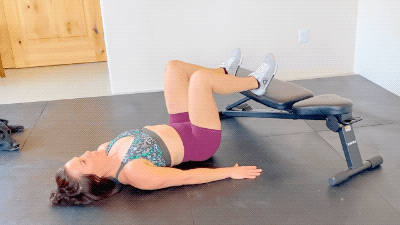
- Place your feet on an elevated surface.
- Inhale while lying on your back.
- Exhale as you lift your pelvic floor, raise your hips, and squeeze your glutes at the peak.
Hip Thrusts
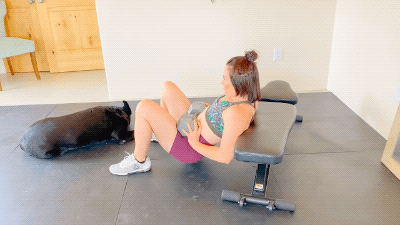
- Position your shoulder blades on a bench or chair.
- Using weights is optional.
- Keep your chin tucked.
- Inhale as you lower your bottom toward the ground.
- Exhale, engage your pelvic floor as you rise up, and contract your glutes in extension.
Deadlifts
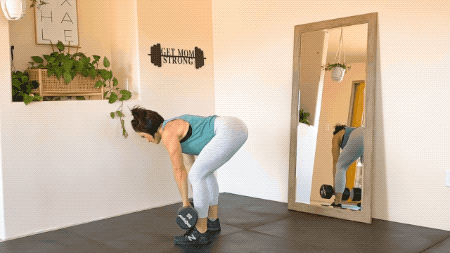
- Maintain a slight bend in your knees.
- Inhale as you hinge at the hips, pushing your glutes backward.
- Exhale as you lift your pelvic floor to stand, ensuring a strong glute squeeze at the top.
Split Squats
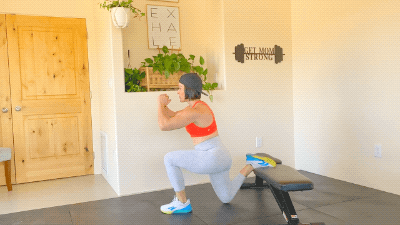
- Place your back foot on an elevated surface.
- Slightly lean forward.
- Inhale as you lower your body.
- Exhale while driving through your front foot to return to a standing position.
Hip Extensions
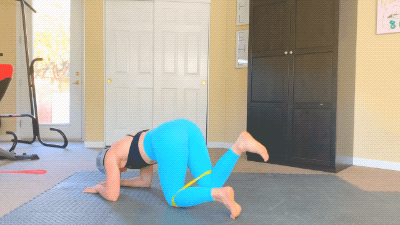
- A resistance band can be used optionally.
- Begin on your forearms.
- Inhale with your knees down.
- Extend one foot toward the ceiling while keeping your knee bent.
Exercises for Strengthening Your Gluteus Medius:
Ball Push Hip Hinge

- Place a soft ball between your knee and the wall, ensuring contact with your outer knee.
- Press your knee firmly into the ball throughout the exercise.
- Hinge at the hips, moving your buttocks backward.
- Exhale, engage your pelvic floor, and stand tall.
Fire Hydrant
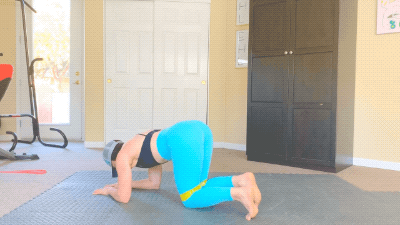
- Start on your forearms with a neutral spine.
- Inhale while your knee is on the ground.
- Exhale as you lift your leg to the side.
- A resistance band can be used optionally.
Clam Bridge
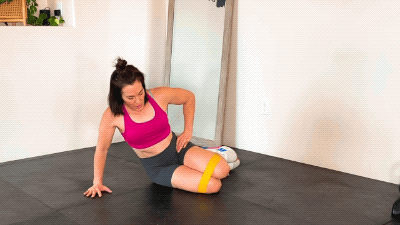
- Ensure your feet align with your glutes behind you.
- Begin with your knees together and your buttocks on the ground.
- Inhale while on the ground.
- Exhale, lift your pelvic floor, and raise your knee.
- Avoid hip rotation.
Lateral Shuffle
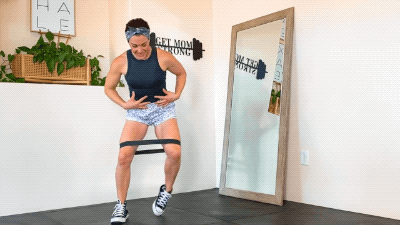
- Place a mini band around the tops of your knees.
- Maintain a slight bend in your knees.
- Continuously push your knees outward against the band while stepping side to side.
Penguins
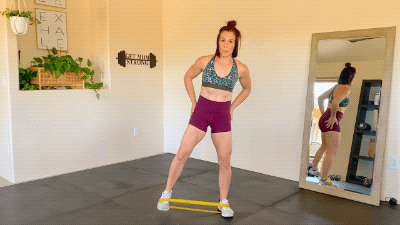
- Use a light resistance band loop around the tops of your feet.
- Stand with a slightly wider-than-hip-width stance.
- Keep a slight bend in your knees.
- Shift your weight from side to side, exhaling with each movement.
Seated Band Abduction:
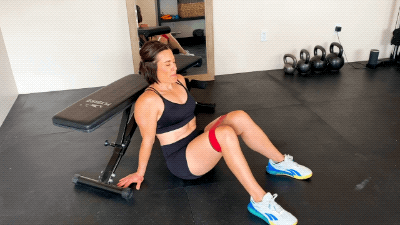
- Lean back slightly.
- Place a resistance band around the tops of your knees.
- Inhale with your knees in a neutral position.
- Exhale, press your knees outward against the band, and engage your pelvic floor.
How Often Should You do Flat Mom Butt Exercises?
To see results and fix a flat mom butt, it is recommended to perform flat mom butt exercises 2 to 3 times per week. It is important to be strategic about your glute workouts and focus on glute-specific exercises. You should perform three sets of each exercise, using loads that are 65 to 85% of your 1RM for 8 to 12 reps. Compound exercises tend to be best for building mass and increasing strength, but adding isolation exercises can also lead to increases in hypertrophy. It is also important to employ the principle of progressive overload when performing workouts to get a bigger booty and fix a flat mom butt.
What are Some Common Mistakes to Avoid When Doing Glute Exercises?
Here are some common mistakes to avoid when doing glute exercises:
- Letting your lower back cave – When squeezing the glutes and extending a leg back, people often let their lower back cave which puts pressure on the lumbar spine. Caving the spine will not only hurt your back, but it also ignores the glutes.
- Not engaging your core – Engaging your core is essential to maintain proper form and avoid injury. When performing glute exercises, make sure to engage your core muscles.
- Bringing the front knee past your toe – When performing lunges, make sure to keep your front knee behind your toe. Bringing your knee past your toe can put unnecessary strain on your knee joint.
- Moving too quickly through reps – Moving too quickly through reps can cause you to lose proper form and not engage your glutes properly. Slow and controlled movements are key to targeting your glutes effectively.
- Not lifting heavy enough – To see results and build glute strength, you need to challenge yourself every single session. Make sure to lift weights that are heavy enough to challenge you.
- Not isolating or hitting all three parts of your glutes – Compound movements like squats and deadlifts are great for overall leg strength, but they don’t always target the glutes effectively. Make sure to include isolation exercises that target all three parts of the glutes.
- Hyperextending your lower back – Thrusting your hips as high as you can at the top of your glute bridge can cause you to hyperextend your lower back. This can lead to lower back pain and make your glute workouts less effective.
How Long Does it Take to See Results from Glute Exercises?
The time it takes to see results from glute exercises can vary depending on several factors such as genetics, diet, exercise routine, and body type. Generally speaking, most lifters should be able to notice a difference in glute growth after 6-8 weeks of consistent training (3-4 days a week of training the glutes directly) and eating enough calories (being in a caloric surplus). However, it is important to note that building muscle is a slow process, and it may take longer for some individuals to see noticeable changes, around 8 weeks or even longer in some cases.
It has been suggested that optimal glute growth can take around 18 months and 2 years to see your final desired result. To see faster results, you should stay consistent and stay with it for 10-12 weeks or longer. It is also important to avoid common mistakes when doing glute exercises, such as not lifting heavy enough, moving too quickly through reps, and not engaging your core.
Are there any Specific Diets or Foods that can Help Transform a Flat Mom Butt?
Yes, following a healthy diet can help transform a mom butt. Here are some tips from the search results:
- Follow a balanced diet that provides adequate nutrition and calories, especially if you’re breastfeeding.
- Focus on eating lean protein, whole grains, fruits, and vegetables.
- Stay hydrated by drinking plenty of water.
- Avoid processed foods and sugary drinks.
- Incorporate healthy fats like avocado, nuts, and olive oil into your diet.
- Eat foods rich in vitamin D, such as fatty fish and eggs, to help build and strengthen muscles.
Are there any Success Stories of Women who have Transformed their Flat Mom Butt?
Yes, there are success stories of women who have transformed their mom butt. Many women have shared their transformation stories on social media platforms like Instagram and YouTube. For example, FitLifeFanatics shared her story of how she transformed her flat and saggy mom butt into a round and shapely one. Similarly, People featured six fit moms who shared their inspiring transformation stories. These women followed a healthy diet and exercise routine to build and strengthen their glutes, resulting in a more toned and lifted butt. Our Fit Family Life also shared eight steps to getting your booty back after baby. These steps include exercises like squats, lunges, and hip thrusts, as well as healthy eating habits. By following these steps, women can transform their flat mom butt into a stronger, shapelier one.
Conclusion
A flat mom butt is a common issue that many women face after pregnancy. However, with the right exercises and healthy habits, it is possible to rebuild and strengthen the glutes. By improving your posture, eating a healthy diet, staying hydrated, and getting enough sleep, you can help your body recover and build muscle. Incorporating exercises such as squats, lunges, hip thrusts, and deadlifts can also help you achieve a stronger, shapelier butt.
Frequently Asked Questions (FAQs)
Can I start these exercises right after childbirth?
It’s best to consult with your healthcare provider before starting any postpartum exercise routine. They can provide personalized guidance based on your recovery.
How long does it take to see results from these exercises?
Results vary from person to person, but typically, you can begin to notice improvements in muscle tone and strength within a few weeks of consistent exercise. However, it may take several months to see significant changes in your overall physique.
Are there any exercises I should avoid if I’ve had a C-section?
If you’ve had a C-section, it’s essential to avoid exercises that put excessive strain on your abdominal area, such as heavy lifting or intense core workouts. Always consult with your doctor for specific recommendations.
Is it safe to include my baby in my workouts?
Yes, incorporating your baby into your workouts can be a fun and bonding experience. Just ensure that the exercises you choose are safe for both you and your baby. Using a baby carrier or stroller for support is a good option.
Can I do these exercises even if I haven’t had children?
Absolutely! While these exercises are particularly helpful for new moms, they can benefit anyone looking to strengthen their glutes, improve posture, and enhance overall fitness. Just tailor the intensity to your fitness level.












